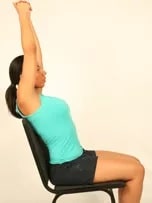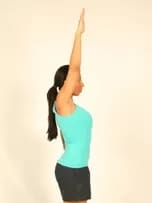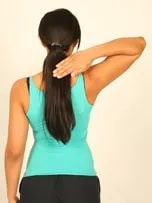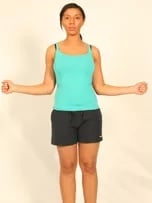Some of the most effective things we can do for our joints are the simplest. Our joints are designed with a range of motion they can achieve, and problems with pain and stiffness can occur if we allow our movements to become limited.
The shoulder is the joint with the greatest mobility, and some of the most limited stability, in the body. It’s designed so we can put our hands where we want them. Shoulder pain is common although in many cases this is more closely related to the neck than the shoulder joint itself.
Relaxation
First, a word about relaxation. More than any other joint, the shoulder is subject to us tensing up and using a bunch of nearby muscles when we try and lift our arm. We lift the shoulder up towards our ear, move our head to the same side and tip our body to the other side, just to try and get that arm up.
Our pain systems respond to tension by amplifying the pain messages and making it more difficult for us to achieve smooth movement of our joints. So, it’s worth looking at yourself in the mirror or having someone watch you, as you try and move your arm. If you’re tensing up, work at relaxing the unwanted movements first before you try and get more movement. Practising relaxation techniques overall can be very useful here but as always, persistence is important until you become skilled at it so you can apply it in normal activities.
The Daily Practice
The daily practice often refers to meditation, exercise, good eating, work etc but here it just means doing the exercises regularly. The payoff comes with time, with keeping going until you begin to see changes.
Putting your shoulder through its full range of movement several times daily can help reduce pain, improve range, increase strength and restore some of the natural movement patterns. It can prevent stiffness and stretch out all the tissues around the joint, allowing the shoulder to be more resilient to physical demands.
Disclaimer
If you have any doubts about doing exercises for pain or stiffness or other condition, you should always consult a physiotherapist, other manual therapist or medical practitioner.
Exercises are definitely not a “one size fits all” situation, it is often important to get guidance individualised to your particular circumstances. These exercises shown here do not constitute medical advice and, in some cases, exercise can make your pain worse rather than better.
How to Do the Exercises
The exercises are very simple and not a magic solution in any way. With time, however, you should find that your problems reduce if you keep going with the exercises you find best or have been shown to do. For further guidance, see The Simple Exercises Series.
If you have chronic (long-term) shoulder pain you may find that the exercises can maintain your movement and use in the arm but do not change the pain much if at all.
Start low by doing one set of five movements and do them slowly and in a relaxed and easy a fashion as you can. As you become more confident and your shoulder does not react badly, you can increase the numbers of sets, the numbers of movements and the times you do them every day. Three times a day, three sets of ten movements would be a good aim with time.
Pendular Exercises
These are great to start things off or after you have had an operation, a fracture or a painful shoulder injury.
NB In the case of an operation or a fracture it is essential that you follow the advice of your doctors and therapists as this can make a big difference to the outcome.
The key here is again relaxation. Lean right forward and put your weight on your good arm on a low table or other stable support. Allow your affected arm to hang downwards, just let it go, let the muscles stop working, just leave it there for a few seconds. In very painful situations this may be enough to start with to try to counteract the tension and overactivity in the shoulder and neck muscles.
To progress from here, perform a small range swinging movement forwards and backwards, making sure the shoulder girdle does not tense up. You should not have to push the arm back and forth, it should just swing easily, as in a breeze. You will find it wants to go in a particular direction which is not straight forward and straight back. That’s fine, let it. You can do the movement a number of times or for 15 or 30 seconds, to get into the swing of things, as it were.
This exercise can be progressed to moving the arm from side to side and then on to rotate the arm, like stirring a large cauldron of soup. You’ll find that stirring one way is harder than the other and that’s ok.
Assisted Flexion

Flexion is the action of lifting your arm straight up in front of you. After pendulums, to increase the difficulty and build strength, you can use your unaffected arm to assist the affected one.
It’s easiest to start by lying on your back. Clasp your affected hand with the other, push both arms up towards the ceiling and then move them up in the direction of over your head. You may not be able to go that far. If you can, fine.
Don’t force the movement. Pain will make you tense up and limited the ease of motion. If it’s easy you can make it harder by doing it sitting or standing up.
Active Flexion

As physios, we call any activity done by a joint with its own muscles, “active” movement. Passive movement is done by someone else or another limb, such as in assisted movement to a degree.
Stand and scan your shoulder area for tension. If there is some, let the muscles go, and do some diaphragmatic breathing to get full relaxation. Then lift the arm up in front of you. It will naturally want to cross slightly over toward the middle as you do this and that’s fine. Again, that’s the natural plane that the shoulder likes to work in.
This is perhaps our most important shoulder movement as it allows us to get our hands up in front of our eyes where we can see what we are doing. With time and relaxation, the movement can increase but again, don’t push hard. Pushing usually means all the extra, unwanted movements start to come in.
Hand Behind Back

Hand behind back (HBB) is a combination of extension (moving the arm behind the body) and medial rotation, turning the arm inwards. It’s a useful, functional movement for putting on a coat, doing up a bra or tucking a top into your jeans.
Move your elbow backwards and start to move your hand around to your back pocket. That may be the limit or you may be able to get it into the small of your back or even further up the spine. Go to where you can easily manage, come out of the movement and repeat.
Hand Behind Neck – The Harder Way

This movement is less obviously useful but we need some lateral rotation, as this action is called, to achieve good flexion. There are two ways of working on this, the easier but less functional way and the harder but perhaps more useful way.
• The harder way. Lift your arm up and put your hand behind your neck. Keep your elbow out to the side if you can. If you slide your hand up your neck and keep your elbow in front, you’ll be avoiding the necessary movement, so check you’re not doing that.
Lateral Rotation – The Easier Way

Keep your elbow into the side of your body. If you find this difficult, hold a paperback book between your upper arm and your side as you do this. Rotate the arm so your hand moves outwards away from your body. Move it back in towards your belly and then repeat. It’s the outer part of the movement that counts here. This technique can be easier and more comfortable to start with your hand pointing forwards as if you were holding a gun towards a target. Then rotate the arm outwards as far as it can easily go until you find a restriction or it’s painful.
Shoulder Girdle Movements
The shoulder area consists of a number of joints and you may need to get the whole area moving to help a pain problem.
Shoulder Shrugs
Shrug both shoulders up as high as you can and then let them down to neutral each time. Once you have done those you can shrug the shoulders down as far as you can, which is quite difficult as it seems that they don’t go very far that way.
Once you practise both movements for a while you can combine them for a complete shrug and right down exercise.
Shoulder Bracing
Sit in a relaxed upright position. Try and bring both your shoulders forward as if you were trying to make them meet in the middle. Then brace them right back to make your shoulder blades (almost) meet at the back. Do a slow, steady, repetitive movement.
There are a bunch of other movements you can do but you’ll probably need the advice of a physiotherapist for any specialised requirements. Abduction or moving the arms out to the side is not a functional movement and, as an eminent shoulder surgeon used to say, “Abduction is for ducks”.
Remember – if you are uncertain in any way, get advice from your physio, manual therapist or medical practitioner.
Last Review Date: 05-02-2019
Next Review Date: 04-08-2020
